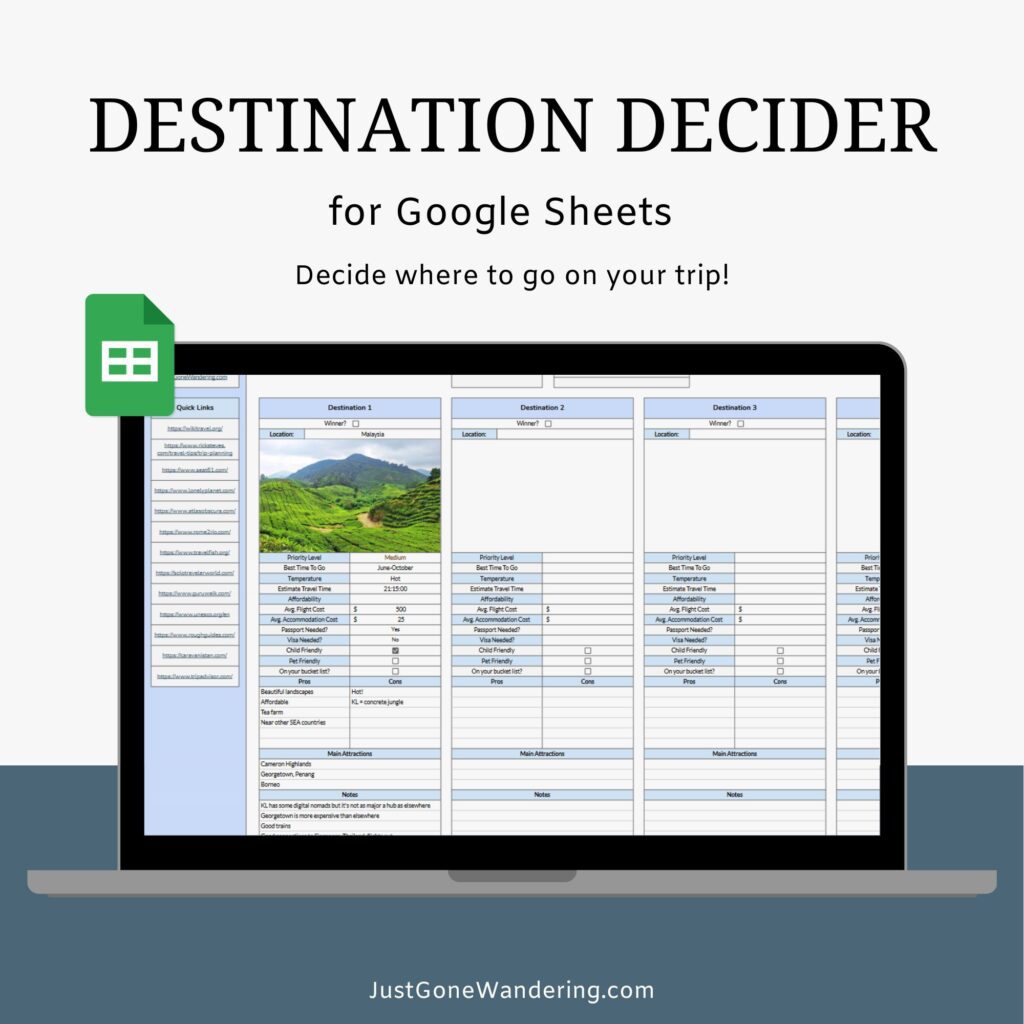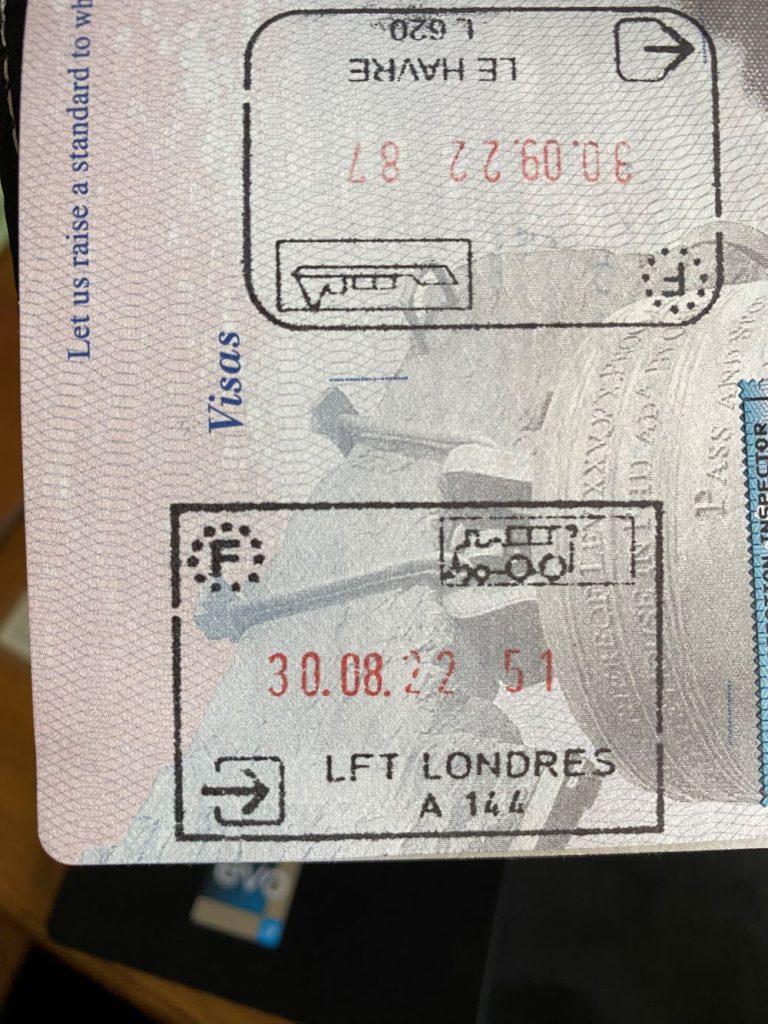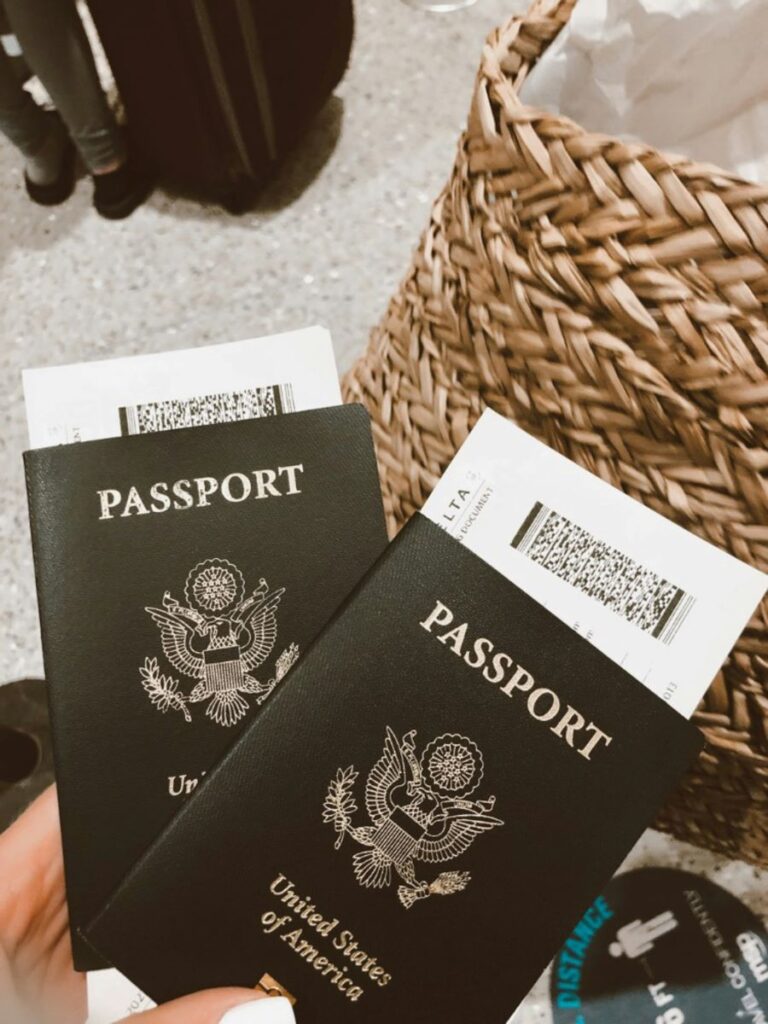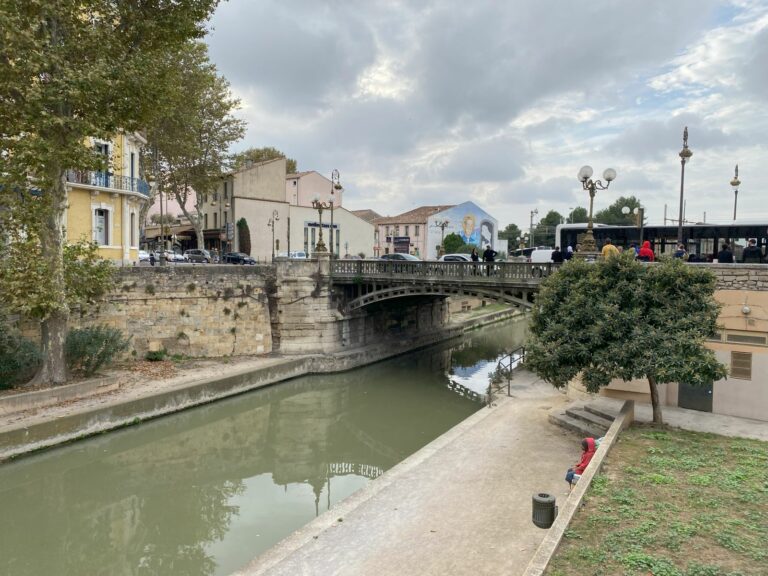What’s the Schengen Zone, Anyway?
Imagine landing in Europe, ready for months of adventures, only to discover there’s a clock ticking on your stay. That’s the Schengen Zone for you.
It’s a group of 29 European countries with shared borders and a unique rule: you can stay 90 days within a 180-day period without a visa. For long-term travelers, especially digital nomads, this can feel like a logistical puzzle—or a serious buzzkill.
But don’t worry, there are ways to work around it and keep your travel plans intact. When you’re plotting your next route, understanding how the Schengen rules work could save you a big headache (or worse).
Ready to keep exploring Europe without breaking a sweat—or the law? Stick around.
shop

Destination Decider
Too many places to visit, and not enough time? Narrow down your choices to the ones that fit your goals the most with the Destination Decider spreadsheet!
Just Gone Wandering is supported by readers! This post contains affiliate links. If you click on a link and buy something, I get a small percentage at no extra cost to you. Your support helps keep this blog running— thank you! Read full disclosure here.
What is the Schengen Zone?

If you’ve ever dreamed about moving seamlessly through European countries without the inconvenience of border checks, welcome to the world of the Schengen Zone.
It’s the traveler’s paradise! …or a potential logistical headache if you’re not paying attention.
But what exactly is it, and how did it all come together to shape the way we explore Europe today? Let’s break it down.
History of the Schengen Zone
The Schengen Zone wasn’t always the well-oiled free-movement machine we associate it with today. Its origins trace back to the 1985 Schengen Agreement, signed in the small Luxembourgish town of Schengen (yep, that’s the namesake).
Five European countries initially agreed on the idea of abolishing internal border controls: Belgium, France, Germany, Luxembourg, and the Netherlands. Visionary, right? But things didn’t happen overnight.
By the 1990s, the Schengen Agreement was integrated into European Union (EU) legislation, which helped the concept of free movement spread faster than you can pack your travel backpack. Today, the Schengen Zone includes 29 countries (Romania was just added this year in 2025!).
Interestingly, not all EU nations are part of it (hello, Ireland), and some non-EU countries like Switzerland and Norway have gotten in on the action too. You can check out more at The Schengen Area Explained – Consilium if you want the nitty-gritty details.
This Zone wasn’t just some hippie idea of “world peace through open travel.” It was a reaction to Europe’s increasing economic integration. Plus, fewer border checks just made practical sense for smaller countries bordering several neighbors. Who needs a passport every other hour on a road trip?
Benefits of the Schengen Zone
At its core, the Schengen Zone is about more than avoiding long lines at customs (although that’s a top-tier benefit). Here are its main highlights, because everything’s more fun with bullet points:
- Facilitating Free Movement of People: If you’ve ever dreamed of hopping between Spain, France, and Italy without needing a new visa every time, that dream exists because of Schengen. It’s like the ultimate travel hack!
- Enhancing Security: Fun fact: Open borders don’t mean no borders. Behind the scenes, Schengen countries collaborate heavily on security measures. Authorities share information and adopt stricter external border rules to ensure that freedom within doesn’t compromise safety. The European Commission’s description of the Schengen Zone dives into the balance between openness and security if you want more info on that.
- Economic Cooperation and Growth: Beyond travel perks, the Schengen Agreement has been a game-changer for the European economy. By simplifying the transportation of goods and travel for workers, industries across the Zone operate more efficiently. Imagine running a multinational business without worry about shipping delays just because your goods crossed a country line—that’s the Schengen Zone at work.
This unified European travel zone is seen as both a freedom and a responsibility. Watching how countries in the Schengen Zone manage their shared external borders (spoiler: it’s not always perfect) is a reminder that cooperation doesn’t come for free.
For travelers, though, the system largely feels seamless—until you run up against the Schengen Area’s 90/180-day rule!
Which Countries are in the Schengen Zone?
When you’re navigating Europe as a long-term traveler, knowing exactly which countries are in the Schengen Zone is kind of a big deal.
Think of the Schengen Zone as Europe’s VIP lounge: a space where internal borders disappear and you’re free to travel like a local. But not every European country is on the guest list, and keeping track of who’s in and who’s out can save you a lot of stress (and fines).
Schengen Member Countries
The Schengen Zone is currently made up of 29 countries, and though many of them are part of the European Union (EU), not all EU countries are in the Zone, and a few non-EU countries are part of the mix (confusing!).
Here’s a detailed list to make things crystal clear:
| Country | EU Member? | Key Details |
|---|---|---|
| Austria | Yes | Cultural crossroads between East and West. |
| Belgium | Yes | Home of the Schengen Agreement. |
| Czech Republic | Yes | Europe’s architectural treasure chest. |
| Croatia | Yes | Popular with digital nomads for great beaches and affordable living. |
| Denmark | Yes | Known for Viking roots and modern design. |
| Estonia | Yes | Digital nomad-friendly and tech forward. |
| Finland | Yes | Where you meet the Midnight Sun. |
| France | Yes | Croissants, castles, and c’est la vie. |
| Germany | Yes | A powerhouse with a rich history. |
| Greece | Yes | Land of myths and Mediterranean breezes. |
| Hungary | Yes | Thermal spas and Danube views. |
| Iceland | No | Nature’s wonderland and Northern Lights. |
| Italy | Yes | Pizza, pasta, and Renaissance art galore. |
| Latvia | Yes | Baltic beauty with vibrant culture. |
| Liechtenstein | No | Tiny, scenic, and peaceful. |
| Lithuania | Yes | Compact with a storied past. |
| Luxembourg | Yes | Small in size, heavy on charm. |
| Malta | Yes | Island vibes and ancient ruins. |
| Netherlands | Yes | Bikes, tulips, and canals – oh my! |
| Norway | No | Fjords, hiking, and endless daylight. |
| Poland | Yes | Medieval squares and rich folklore. |
| Portugal | Yes | Coastlines that make any traveler swoon. |
| Romania | Yes | Huge castles and ancient cities. |
| Slovakia | Yes | Majestic mountains and friendly locals. |
| Slovenia | Yes | Small, green, and picturesque. |
| Spain | Yes | Flamenco, festivals, and sunny siestas. |
| Sweden | Yes | Clean cities and breathtaking forests. |
| Switzerland | No | Precision clocks, beautiful peaks. |
Notable outsiders include Ireland, which operates under its own travel rules, and countries like the United Kingdom, which opted out entirely post-Brexit.
For nomads, it’s not only crucial for plotting your next move but also for sidestepping annoying post-90-day consequences. When rules change (and they will), staying informed means traveling smarter, not harder.
Pro Tip: If you’re a digital nomad, research specific long-stay requirements by country. Some countries offer visas catering to remote workers or freelancers, which means you can stay longer within that single country.
Long-Term Travelers in the Schengen Zone
Navigating the Schengen Zone requires planning, especially if you’re on a prolonged European getaway.
Beyond the romantic allure of hopping between historic cities and breathtaking landscapes, there are rules and realities to consider. For long-term travelers, these can either open up infinite possibilities or create logistical roadblocks, depending on how well you prepare.
Travel Flexibility
One of the most exciting parts of exploring within the Schengen Zone is the ability to move freely between 29 countries without border checks. You usually only get one stamp into the Zone and one stamp out again, with nothing needed between.
You could be enjoying tapas in Barcelona one day and wandering through lavender fields in Provence the next, without having to “cross a border.” Pretty nice, right?
This “border-free Europe” is a dream for those who like to keep their plans loose. You don’t need to spend hours researching border crossings or worry about visa approvals when traveling between Schengen nations. It’s as easy as driving to a neighboring town at home! This freedom makes exploring Europe feel like a cohesive journey rather than a patchwork of separate trips.
- Flights and Trains Are Straightforward: With no internal borders, booking flights or trains within the Zone is a breeze. Plus, no one will stop and ask you why you’re moving from Germany to the Czech Republic for the weekend.
- Easier Pace: The absence of restrictive internal borders lets you slow down and sink into the cultures. Long-term travelers can experience as many as four countries in just a couple of weeks without dealing with border chaos.
Traveling this freely gives you a taste of the idealized traveler’s Europe, where adventure waits across every horizon. If you’re planning your next route or figuring out the logistics of how to plan full-time travel, this perk definitely works in your favor. But, there’s a flip side…

Schengen Zone Limitations
Here’s the kicker: while you can bounce around Schengen countries like you’re running the world’s most exciting relay race, there’s a catch.
Remember the 90/180 rule? Yeah, that.
The rule says non EU-passport holders can only stay in the Schengen Zone for 90 days in any rolling 180-day period. This means that three months is the max before you need to high-tail it out of there for at least another three months.
If you’re used to traveling in Southeast Asia where you can just border hop to get a fresh visa, this might be confusing. So remember! The Zone’s 90 days DO NOT HARD RESET when you leave the Schengen Zone.
It takes some getting used to, but a good way to do visualize it is by using a calculator like this one. I’ve also kept track of my Schengen Zone days using my travel planner spreadsheet.
Staying Longer than 90 Days
If you’re anything like most nomadic travelers, three months in Europe kind of feels like barely scratching the surface.
Want to extend your stay in the Zone?
There are options like country-specific visas, which allows longer stays in individual countries like France or Portugal. Usually these are either digital nomad visas, student visas, or some kind of retirement visa. However, those usually restrict you to staying within that same country rather than being able to jump around the Zone willy-nilly.
Nomad Girl has a great list of countries offering digital nomad visas if you’re interested in that.
The Schengen Shuffle
Alternatively, you can do the “Schengen Shuffle,” where you alternate stays in the Zone with stays outside the Zone. 90 days in, 90 days out, over and over until you get bored and want to try a different region of the world. ;P
Some popular non-Schengen countries with long-term travelers are:
- Albania (US passport holders get 1 year visa-free entry!)
- Georgia (US passport holders get 1 year visa-free entry!)
- Estonia
- Bosnia and Herzegovina
They’re close enough to the Schengen countries that getting in/out again is easy and affordable, as you can take a train or a bus over the border.
Final Thoughts
The Schengen Zone is both an opportunity and a challenge for long-term travelers. It opens up a borderless Europe with incredible ease of movement but demands strategic planning due to its 90/180-day rule. By understanding how to navigate it and exploring visa options like long-stay permits, you can make the most of Europe without unneeded stress or legal trouble.
Schengen Zone FAQs
What is the Schengen Zone?
The Schengen Zone is a group of 29 European countries that have removed internal border controls, allowing people to move freely between them. Think of it as a big, border-free travel zone within Europe.
Which countries are part of the Schengen Zone?
The 29 Schengen countries are Austria, Bulgaria, Belgium, Czech Republic, Croatia, Denmark, Estonia, Finland, France, Germany, Greece, Hungary, Iceland, Italy, Latvia, Liechtenstein, Lithuania, Luxembourg, Malta, Netherlands, Norway, Poland, Portugal, Romania, Slovakia, Slovenia, Spain, Sweden, and Switzerland.
Does the 90-day rule apply to all travelers?
Yep, mostly. Tourists from countries like the US, Canada, and Australia can stay for up to 90 days within any 180-day period. After 90 days, you’ve gotta leave or get a visa.
Can I stay longer than 90 days?
Not without a visa. Long-term travelers need a visa (like a work, student, or residence visa) from one of the Schengen countries to extend their stay. Overstaying can get you fined, deported, or even banned from re-entry.
How does the “90/180-day rule” actually work?
The rule isn’t about 3 months in a row; it’s about 90 days in any rolling 180-day period. Your time resets 180 days from the first day you entered. Pro tip: Use a Schengen calculator to track your days.
Are there ways to reset my 90 days?
Not within the Schengen Zone. Once you hit your 90 days, you have to leave and wait until more days “open up” within that 180-day window.
Do I need a visa to enter the Schengen Zone?
That depends on your nationality. Many countries are visa-exempt for short stays (include the US), but starting from 2024, you’ll need an ETIAS authorization for entry.
Can I visit multiple Schengen countries during my 90 days?
Yes! Once you’re in, you can move freely between countries without border checks. It’s like one big open playground—just watch your day count.








